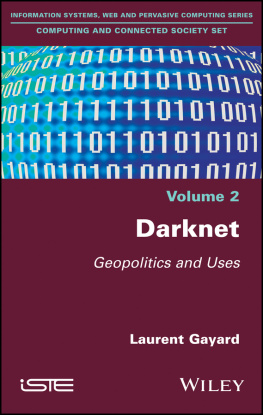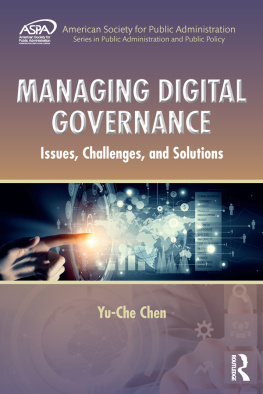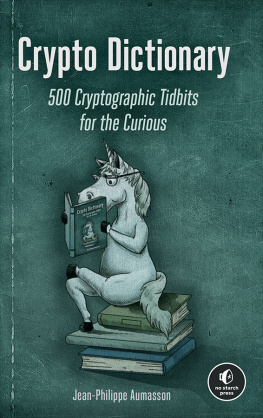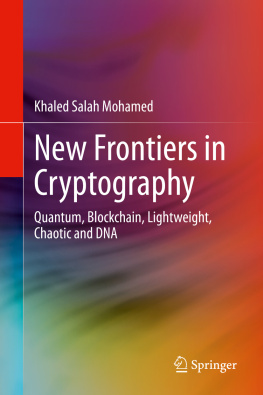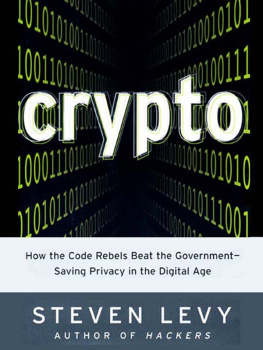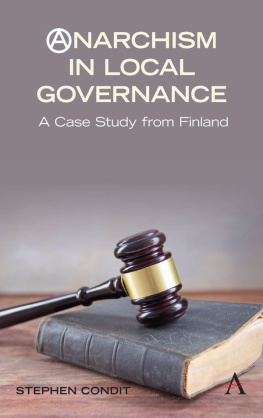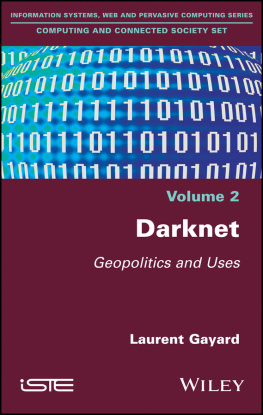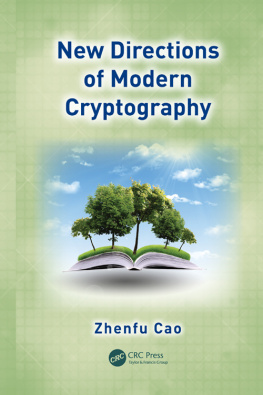
Computing and Connected Society Set
coordinated by
Dominique Carr and Genevive Vidal
Volume 2
Darknet
Geopolitics and Uses
Laurent Gayard
First published 2018 in Great Britain and the United States by ISTE Ltd and John Wiley & Sons, Inc.
Apart from any fair dealing for the purposes of research or private study, or criticism or review, as permitted under the Copyright, Designs and Patents Act 1988, this publication may only be reproduced, stored or transmitted, in any form or by any means, with the prior permission in writing of the publishers, or in the case of reprographic reproduction in accordance with the terms and licenses issued by the CLA. Enquiries concerning reproduction outside these terms should be sent to the publishers at the undermentioned address:
ISTE Ltd
27-37 St Georges Road
London SW19 4EU
UK
www.iste.co.uk
John Wiley & Sons, Inc.
111 River Street
Hoboken, NJ 07030
USA
www.wiley.com
ISTE Ltd 2018
The rights of Laurent Gayard to be identified as the author of this work have been asserted by him in accordance with the Copyright, Designs and Patents Act 1988.
Library of Congress Control Number: 2018932685
British Library Cataloguing-in-Publication Data
A CIP record for this book is available from the British Library
ISBN 978-1-78630-202-1
Preface
According to Stanford. We hope that this book will at least partially enlighten the reader on the essential issues of the transformation of the communication society that could change digital usage, public policy and, of course, our daily life in the near future.
Laurent GAYARD
February 2018
Stanford University. Private American University, located in the heart of Silicon Valley, south of San Francisco. In 1968, Stanford University was linked to the University of Los Angeles (UCLA) and the University of Utah through the first offshore computer network that took the name ARPANET and foreshadowed the creation of the Internet. Fadi Chehad, Director of the
Internet Corporation for Assigned Names and Numbers (ICANN). 55th ICANN Congress, Marrakech, March 7, 2016. By clearly distinguishing this expression from Web 3.0 that implies the Internet of Things.
Introduction
On October 17, 2011, the Anonymous group launched a darknet operation, revealing the existence of some forty pedophile sites hosted on the Tor network, reached a little media fame at the time.
In 2016, Sir David Omand, former director of GCHQ in the denomination of darknets, the term already pluralized. As early as 2003, the four researchers predicted the irremediable expansion of this phenomenon [BID 03]: We expect that the effectiveness of the darknet as a distribution mechanism will run into some obstacles in the short term, but ultimately, the genius of the darknet will be indelible.
In 2003, Biddle, England, Peinado and Willman combined the idea of the darknet exclusively with illegal distribution networks for licensed content. The problem that arose at that time, synthesized in the study of the four engineers, was still limited to illegal downloading and the threat posed by this growing phenomenon to the cultural industry. But if the origin of the darknet concept can be linked to the development of illegal download networks, the term also refers to a specific culture linked to technological developments marking the turn of the 20th and 21st century. On February 8, 1996, U.S. President Bill Clinton signed the Telecommunications Act, accompanied by the Communications Decency Act. This initiative represented a historic step in the process of liberalizing telecommunications and online services such as the Internet. The Telecommunications Act replaced the old Communications Act of 1934, attempting to take into account the radical changes in American society during the 1960s, 1970s and 1980s. The main idea of the legislation was to foster the development of competition in the telecommunications sector and to facilitate the entry of large private groups into a sector originally dominated by the American Telephone & Telegraph Corporation. Initially intended to promote the opening up of the telecommunications market to multiple groups, the Telecommunications Act actually led to the creation of new telecommunication giants and the disappearance of a large number of minor operators in this sector. Many observers accused the Telecommunications Act of having paved the way for the complete domination of the mass media. In this case, the new legislation allowed a few major operators to take over the market of internet access providers, such as UUNet (now Verizon), Sprint Corporation, Level 3 Communication (acquired on October 31, 2016 by Centurylink), Comcast and AT&T. In the aftermath of Bill Clintons announcement that he had signed the Telecommunications Act, John Perry Barlow, co-founder of the Electronic Frontier Foundation, in which he stated that no government, corporation or institution should impose its authority or claim on any property rights over the Internet. In particular, the declaration, which was addressed to governments and leaders of major economic consortia, proclaimed: You are not welcome here. You have no sovereignty where we meet. We form our own social contract. The cyber-revolutionary rhetoric, such as that of John Perry Barlow, may seem quite fanciful today. However, it still applies today, through multiple small groups, individual operators, sites and discussion forums, fervently defending the idea of a Freenet instead of a darknet, in order to reintroduce the name given to the social network created in 2010: an anonymous and free Internet 3.0, on which the user always remains in control.
However, 20 years after the publication of the Declaration of Independence of Cyberspace, times have changed, as has the Internet. According to figures from the Data Observatory. The exponential rate of development of the Internet today makes any calculation partially obsolete: some authors state a trillion pages have been created, that is to say a thousand billion, etc. [PIS 08, p. 188]. This exponential growth interests public and private companies, anxious to take advantage of the economic opportunities offered by the deep web and Big Data. It also opens up new opportunities for all those who intend to benefit from the growth of the global network, which increasingly calls into question the ability of state structures to effectively monitor the multiple networks that make up the Internet today. This desire to escape the control of institutions responds to economic and ideological motivations and is in line with the promises, sometimes illusory, of a globalized system that makes all forms of borders, barriers and regulations obsolete.
The recent development of darknets, which are no longer just networks of exchange, but real layers of alternative networks superimposed on the global network, contains all the questions raised by the exponential growth of intangible flows, the modification of digital usage and the questioning of the regulatory status of States. The latter, as well as the security and intelligence agencies that depend on them, are now becoming aware of the danger attached to the idea of virtual lawless zones that are somewhat or totally beyond their control. All of them are therefore stepping up their efforts to develop credible and effective policies in the field of cybersecurity. The resurgence of terrorism, but also other illegal activities such as trafficking in drugs, weapons and human beings, which are using new technologies in order to develop, is giving rise to policies for the security and surveillance of cyberspace. In turn, they are severely criticized and questioned by some sections of civil society who, on the contrary, highlight the usefulness of these spaces where anonymity is relatively preserved for journalists or dissidents threatened by authoritarian regimes, thus allowing the free flow of information and freedom of expression. However, States are also using the capabilities offered by darknets to create a new form of interstate or asymmetrical conflict for themselves, that is now taking place in virtual space, but has very severe consequences in the form of cyber-attacks, such as the large-scale one that took place in Estonia in 2007, inaugurating the entry into a new dimension of modern warfare. While, according to journalist Duncan Campbell [CAM 07], States have been losing the battle of cryptography to prevent the spread of advanced encryption techniques in civil society since the 1990s, it seems that Tor-like encrypted networks now offer capabilities to resist cyber-attacks and are also of interest to States and companies wishing to better protect their online databases.
Next page
